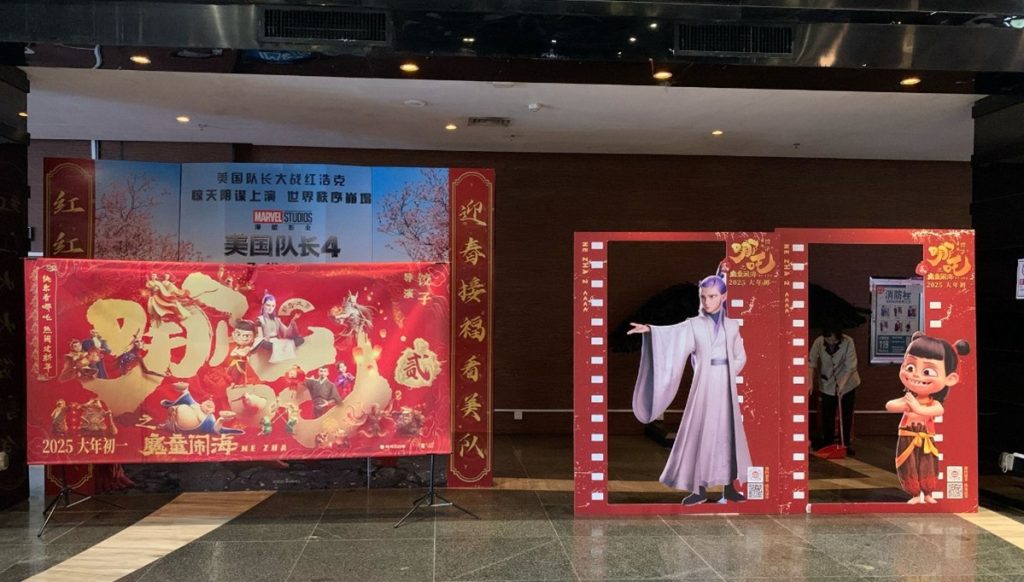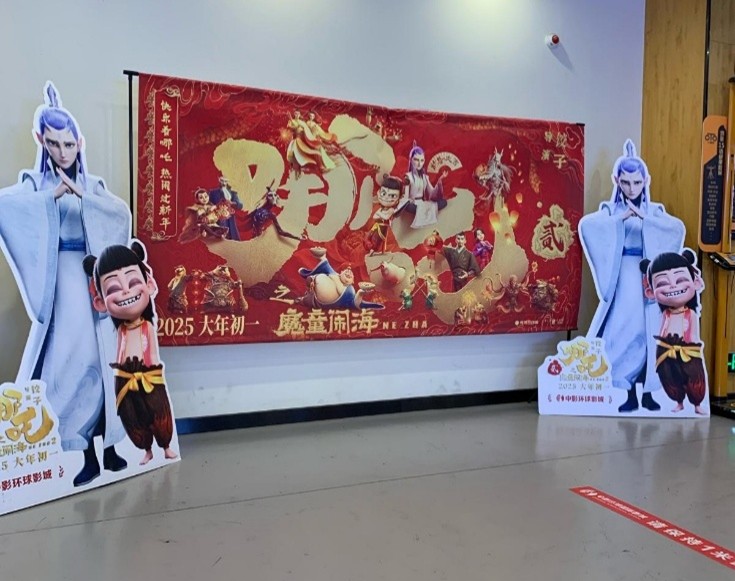Early this year, a BBC article reported that a Chinese animated film Ne Zha 2 (2025) has become ‘a source of national pride.’ During my field trip to China in March this year, I was fortunate enough to watch this popular animated film Ne Zha 2 at a local cinema in Nanning, the capital city of Guangxi Autonomous Region. The friend who accompanied me was watching it for the third time. By then, it had been over a month and a half since the film’s release in January 2025, and its worldwide box office earnings had already surpassed 2 billion US dollars.
As a researcher who explores Chinese animation, what interests me is not just the performance at the box office but also how media, technology, creativity, and cultural heritage are entangled with the politics of soft power and cultural nationalism in China. I argue that Ne Zha 2 is an example of post-2010 Chinese animation that aims to excel in terms of a distinctive Chinese aesthetic and cultural content, as a form of techno-nationalism.


Chinese cinema displays with Ne Zha 2’s banners and standup character cutouts in front of a poster of Captain America 4. Photo credit: Author
Who is Ne Zha?
Directed by Yu Yang (aka: Jiaozi), the Ne Zha animated film series is an adaptation of the stories of Ne Zha, a well-known mythical character with superpowers, originally known from the 16th-century Chinese epic Fengshen Yanyi (封神演义 Investiture of the Gods). In this epic, Ne Zha was the third son of Li Jing, a general in Chentangguan (陈唐关). When he was a child, Ne Zha was in conflict with Ao Bing, the third son of the Dragon King of the East Sea. Ne Zha killed Ao Bing and stripped him of his dragon tendon. The Dragon King of the East Sea became angry, and in order to end the conflict, Ne Zha chose to die by suicide. After being reborn and having other adventures, Ne Zha followed his father to join a fight against the King Zhou of Shang, which was ultimately successful.
Despite Nezha’s stories playing a small part in the Investiture of the Gods, he is very popular due to his rebellious nature. His stories have been revisited many times in the history of Chinese animation. The most well-known adaptation is the animated film produced by the Shanghai Animation Film Studio (SAFS) in 1979, Nezha Conquers the Dragon King. Furthermore, the portrayal of Ne Zha and his traditional Chinese patrilineal relationship with his father has been widely discussed in public discourse and academic forums.
Nezha Conquers the Dragon King achieved a high level of artistry, as it utilised many traditional elements to inspire the creative process. For example, the image of Ne Zha resembles that of a New Year’s painting (年画nianhua) while the music incorporates many elements of Peking Opera and folk music. This animated film reflects the exploration of Chinese cultural characteristics in animation before the Economic Reform (1978) and embodies the aesthetic of the ‘Chinese School’, promoted by SAFS.
The plot of Jiaozi’s Ne Zha: Birth of the Demon Child (Ne Zha 1, 2019) and Ne Zha 2 (2025) is not a literal interpretation of Investiture of the Gods, with the director and screenwriters making major adaptations to the storyline. Changes have been made to cater to the current market and to appeal to the younger generation in China. For example, this animated film aligns with the cinematic language of blockbuster movies, with many of the fighting scenes incorporating high-quality visual effects.
The Chinese animation industry
The contemporary Chinese animation industry has, in general, been found wanting by fans. With government support, the Chinese film industry receives more attention from Chinese audiences. Although China’s animation industry has government support, domestic animation, from the level of artistry to the storyline, is not as popular now as it was in the period before the Economic Reform (1978). Chinese animation is dominated in the market by Disney and Japanese anime.
Ne Zha 1 and Ne Zha 2 are among the most successful Chinese animations in terms of box office performance. With Ne Zha 1’s box office success, it is unsurprising that Ne Zha 2 also performed well, leveraging the interest of the existing audience. However, other animated films have not performed so well. For my PhD research, I have interviewed Chinese animators, and they offered a number of critical viewpoints on this situation. First, they pointed out that not every animation studio in China has the capacity and courage to make an animated film like Ne Zha. Second, some interviewees felt that the success of Ne Zha 1 might not be representative of the industry’s overall success. Most productions do not perform well at the box office, which can lead to financial difficulties for animation studios.
The Chinese artistic style that SAFS explored before the Economic Reform is now being recognised for its aesthetic characterised by distinctive artwork and graphics. This is also reflected in contemporary Chinese animation production, where considerable effort is put into character designs and CG effects, with the hope that the visuals emulate Chinese aesthetic style. In this regard, some scholars argue that this spectacle in film production technology produced by Chinese animation studios constitutes a kind of techno-nationalism. With advanced technology, Chinese animation seeks to produce works that are found to be comparable to non-Chinese animation, generating a sense of nationalistic achievement and pride.
The plot of Ne Zha 2 is tightly organised, and there are many interesting lines in the film that require further interpretation by audiences, adding value to the viewing experience. For instance, when Taiyi Zhenren, Ne Zha’s master, saw Ao Bing’s version of Ne Zha, he said, ‘This is the authentic Ne Zha.’ This line interests me because Jiaozi uses it to pay homage to SAFS’s classic character design of Ne Zha, emphasising the different character design of Ne Zha in his film. This is a reference that only an audience familiar with Chinese culture and the 1979 version of Ne Zha would understand. The extensive use of cultural references enhances the viewing experience for the domestic audience.
Soft power
The Chinese government frequently uses the concept of soft power in cultural policy, and in the last two decades, it has increased its focus on promoting Chinese culture, in order to advance national culture confidence. For example, in Nanning, I observed many new street signs about local intangible cultural heritage, proudly promoting cultural traditions and everyday heritage, as a source of local pride.

Oil Tea (油茶), national listed intangible cultural heritage in Nanning. Photo credit: Author
National cultural resources have been a rich source of creativity for Chinese animations, not just Ne Zha, but many others, such as Monkey King: Hero is Back (2015), White Snake (2019), Jiang Ziya (2019) and Chang’an (2023). Chinese cultural policy shows that the government is keen to see more animated films that promote Chinese culture and traditions, which are considered ‘national treasures.’ Ne Zha 2 is an example for Chinese animators to imagine Chinese animation today, with a high level of artistry, some humorous but localised plots, and intense fighting scenes with advanced ‘CG showmanship.’ The film is aimed at the domestic audience but is also envisaged as expanding cultural influence overseas.
